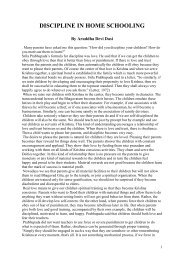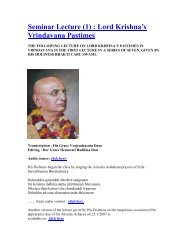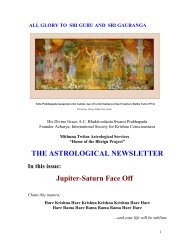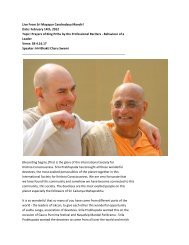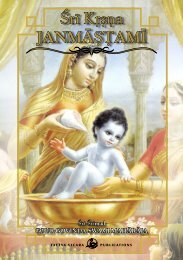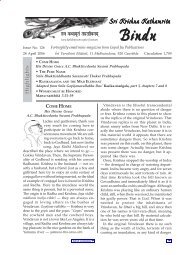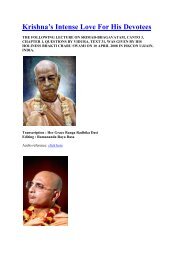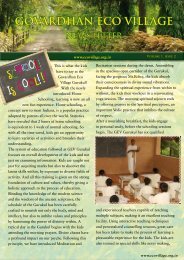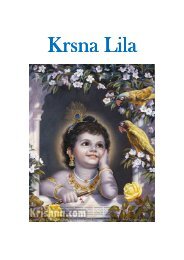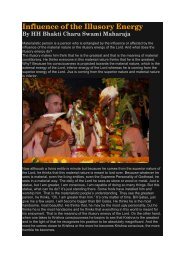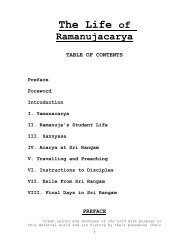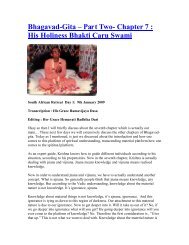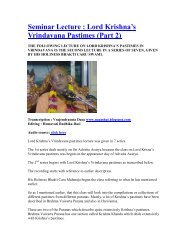Gaudiya siddhanta - ebooks - ISKCON desire tree
Gaudiya siddhanta - ebooks - ISKCON desire tree
Gaudiya siddhanta - ebooks - ISKCON desire tree
You also want an ePaper? Increase the reach of your titles
YUMPU automatically turns print PDFs into web optimized ePapers that Google loves.
yada bhramam bhramam harirasagalad-vaisnavajanam<br />
kadacit sampasyamstadanugamane syadruciyutah<br />
tada krsna vrttya tyajati sanakairmayaikadasam<br />
svarupam vibhrano vimalarasabhogam sa kurute<br />
"After repeatedly wandering in the path of mayik existence, a fallen soul may meet a pure Vaisnava<br />
from whom trickles the nectar of the mellows of pure devotion to Lord Hari. By following that pure<br />
devotee, he becomes attracted to imbibe the sweet principle of devotional service. By constant study of<br />
Krsna-bhakti, he slowly abandons the mayik condition, and in the end obtaining his true nature, he<br />
enjoys the sweetest unalloyed rasa, which is the ultimate status of the soul."<br />
It is to be understood that there is a progression in the descent of divine knowledge. Sri Madhva<br />
preached the philosophy of Dvaitavada in order to counter the widespread Mayavada doctrine of Adi<br />
Sankara which was prevalent at that time.<br />
It is acknowledged by the <strong>Gaudiya</strong> school that the doctrine of Dvaita is an intrinsic part in the evolution<br />
of theism. It was propagated according to kala and patra (time and circumstance) and was not meant to<br />
be the last word in the Absolute Truth.<br />
Rasa-tattva is a very subtle truth and could not have been taught during that period of India’s history.<br />
The necessity of the time demanded that a powerful acarya boldly expound the basic beliefs of the Vedic<br />
scriptures and burn the weeds of Advaitavada to the roots. It is only fitting that the incarnation of<br />
Bhima performed this task. How could such a forceful personality explain the subtle divine mellows of<br />
madhurya-rasa? This would be inconsistent with his character. Therefore the intricate concepts of rasavicara<br />
were later expounded by Sri Caitanyadeva and His followers.<br />
Our Tattvavadi friends raise the question as to why Baladeva wrote a commentary on the Brahmasutras<br />
when Sri Madhvacarya had already done so. It is understood that Srimad Bhagavatam is the<br />
natural commentary on the Brahma-sutras. This is stated in Garuda Purana —<br />
artho ’yam brahma-sutranam<br />
bharatartha-vinirnayah<br />
gayatri-bhasya-rupo ’sah<br />
vedartha-paribrmhitah<br />
grantho ’stadasa-sahasrah<br />
srimad-bhagavatabhidhah<br />
"The Srimad-Bhagavatam is the authorized explanation of Brahma-sutras, and it is a further explanation<br />
of Mahabharata. It is the expansion of the gayatri-mantra and the essence of all Vedic knowledge. This<br />
Srimad-Bhagavatam, containing eighteen thousand verses, is known as the explanation of all Vedic<br />
literature."<br />
However, since Sankara commented upon the pristine teachings of Vyasa found in the Brahma-sutras, it<br />
was the duty of the Vaisnava acaryas such as Sri Ramanuja and Sri Madhva to counter his doctrine of<br />
illusion and present their own commentaries.<br />
Sri Sri Radha-Govindadeva




